The world's TASTIEST cakes: which British ones made the list?
Incredible cakes from around the globe

larry mcguirk/Shutterstock
Layered, squared, iced, sliced – no matter how you like yours, there’s no denying that cakes are loved the world over. And with so many countries boasting their own creations, there are some unique bakes to try, serving up history and tradition in every bite. From celebration cakes to everyday favourites, we've compiled the ultimate list of the best cakes from around the world, counting down to the most delicious of them all.
Read on to discover the tastiest cakes the world has to offer. How many have you tried?
We’ve based our ranking on the popularity and cultural significance of each cake in its place of origin and beyond, and on the opinions of our well-travelled (and well-fed) team. The list is unavoidably subjective.
44. Fondant fancies, England, UK

gourmetphotography/Shutterstock
Many British people will know fondant fancies as French Fancies, the name given to them by the brand Mr Kipling when they first went on sale in 1967. Inspired by French petit fours (bite-sized cakes), the little sponge squares are topped with a dot of buttercream, covered in flavoured fondant icing, then drizzled with melted chocolate. Homemade and artisan versions are now popular too, with flavours, colours and finishes often taking a departure from the originals to include elements such as jam and marzipan.
43. Castella, Japan

Romix Image/Shutterstock
Japan’s castella cake (known in Japanese as kasutera) is a moist and fluffy sponge cake inspired by Portuguese bakes brought to the country by merchants in the 16th century. Despite the cake's Portuguese origins and a name that references Spain – from the Portuguese bolo de Castela, or cake of Castile – it’s now seen as a type of wagashi (traditional Japanese confectionery item), with flavours ranging from plain to chocolate and matcha. Traditionally baked in a wooden frame, its batter incorporates honey into whisked eggs for a sweet flavour and fine texture.
42. Parkin, England, UK

zoryanchik/Shutterstock
Originating in Northern England, with a particularly strong association with the counties of Yorkshire and Lancashire, sticky gingerbread-style parkin is traditionally enjoyed in autumn, both on and around Bonfire Night (5 November). The cake’s batter contains oatmeal, golden syrup and treacle, and is spiced with ginger, nutmeg and other warming spices. After baking, it's often left for at least a few days – and sometimes, up to a few weeks – to allow it to get stickier and moister as both the texture and flavour develop.
41. German chocolate cake, USA
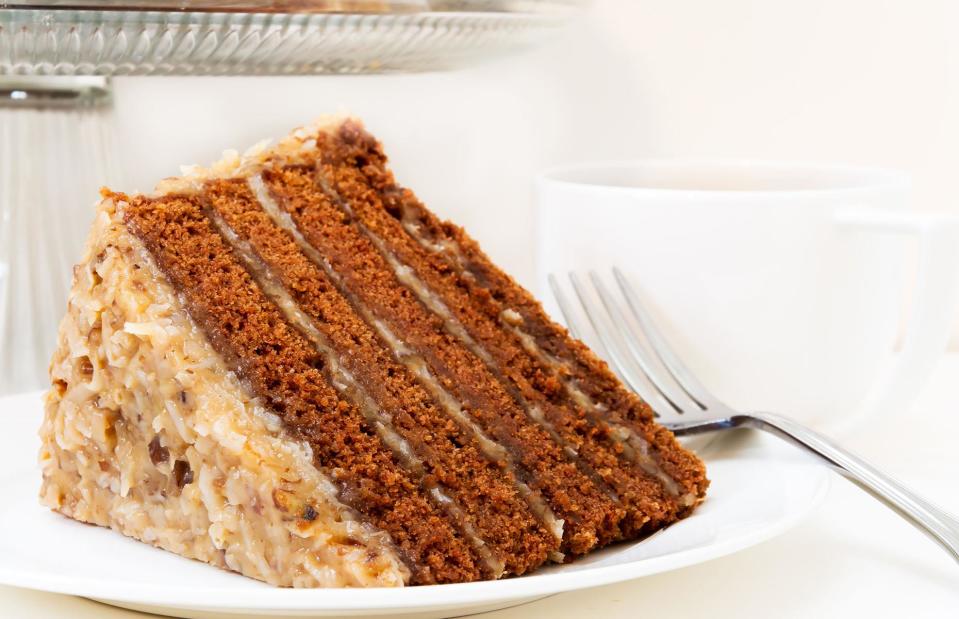
Danny E Hooks/Shutterstock
Don't let the name fool you; this cake has nothing to do with Germany. It was created by Texan homemaker Mrs George Clay in 1957, and it was originally called 'German's chocolate cake' because the recipe used a baking chocolate invented by Samuel German for the Baker Chocolate Company. When Mrs Clay's recipe was published in The Dallas Morning News, General Foods, which owned the Baker brand, distributed it to other newspapers across the States. The 's' was dropped from the name – and a legendary cake was born. The many-layered masterpiece, complete with coconut-pecan frosting, is still popular to this day.
40. Fraisier, France

OlgaBombologna/Shutterstock
A ring of strawberries sits pretty in the centre of a fraisier: a cake whose roots stretch back to the 16th century, when royal chefs sought to find new ways to impress with their pâtisserie skills. The strawberries are set within a layer of crème pâtissière or crème mousseline, which is layered between two Génoise sponges. The result is a light and airy cake that’s at its best when strawberries are in season – and therefore as sweet and juicy as possible.
39. Amandine, Romania

Cristian Zamfir/Shutterstock
Chocolate, chocolate and yet more chocolate is the key to these little layer cakes, a favourite in Romania’s sweet shops. To make them, chocolate sponge is soaked in rum, layered with chocolate or almond buttercream, coated in a silky chocolate glaze, then topped with a dollop of chocolate cream and a thin chocolate decoration. Amandine cakes can be found throughout Romania, and they've been popular since the 1960s.
38. Barmbrack, Ireland

Happy Foods Tube/Shutterstock
Flavoured with black tea and warming spices such as cinnamon and nutmeg, barmbrack, or Irish tea cake, is packed full of juicy fruit, including currants and sultanas. It’s baked in a loaf shape as a nod to traditional recipes; it was first made as a yeasted bread. Today it’s usually made with baking powder and enjoyed sliced and buttered – especially on Halloween and other special occasions. A lucky few might find a charm baked into their slice, something that’s said to give an insight into their future.
37. Rigó Jancsi, Hungary

Hans Geel/Shutterstock
Chocolate cakes are a favourite around the world, and many countries have their own tasty variations. Simple yet decadent, this Hungarian chocolate cake is one of them. Named after a famous Hungarian Romani violinist, it features layers of moist chocolate sponge cake and a creamy chocolate filling, which is sometimes laced with rum or vanilla. The whole cake is glazed with a dark chocolate fondant, giving it a sophisticated finish worthy of any celebration.
36. Foi thong cake, Thailand
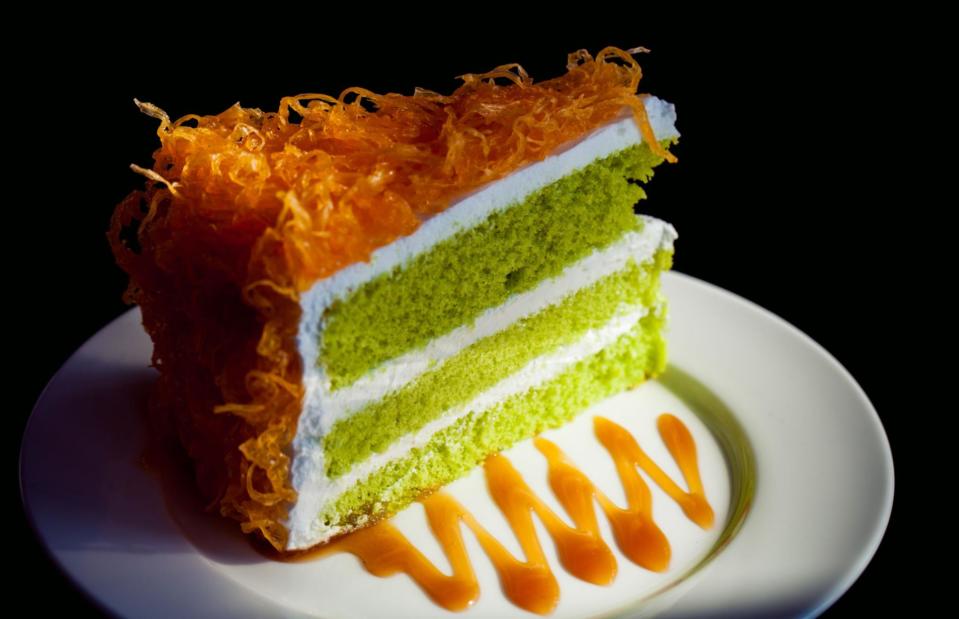
Chaikom/Shutterstock
Based on the belief that gold brings good luck, foi thong – which translates to ‘golden threads’ – is traditionally served at weddings and celebrations in Thailand. The vibrant orange strings are made by piping duck or chicken yolks into a boiling sugar syrup infused with pandan leaves. Today, foi thong is often used to top a pandan chiffon cake: a light, fluffy sponge with hints of vanilla, coconut and floral notes.
35. Brigadeiro, Brazil

gustavomellossa/Shutterstock
A must-have for birthday celebrations in Brazil, the brigadeiro cake is a super-sweet celebration of chocolate. This iconic cake is filled and iced with the Brazilian sweet treat brigadeiro, a fudgy chocolate mix that’s usually rolled into balls and covered in chocolate sprinkles. It has many handy uses: it can hold together chocolatey layers or decorate a simple bundt. No matter what shape the bake may be, the sprinkles will give it a delicious final flourish.
34. Hummingbird cake, Jamaica
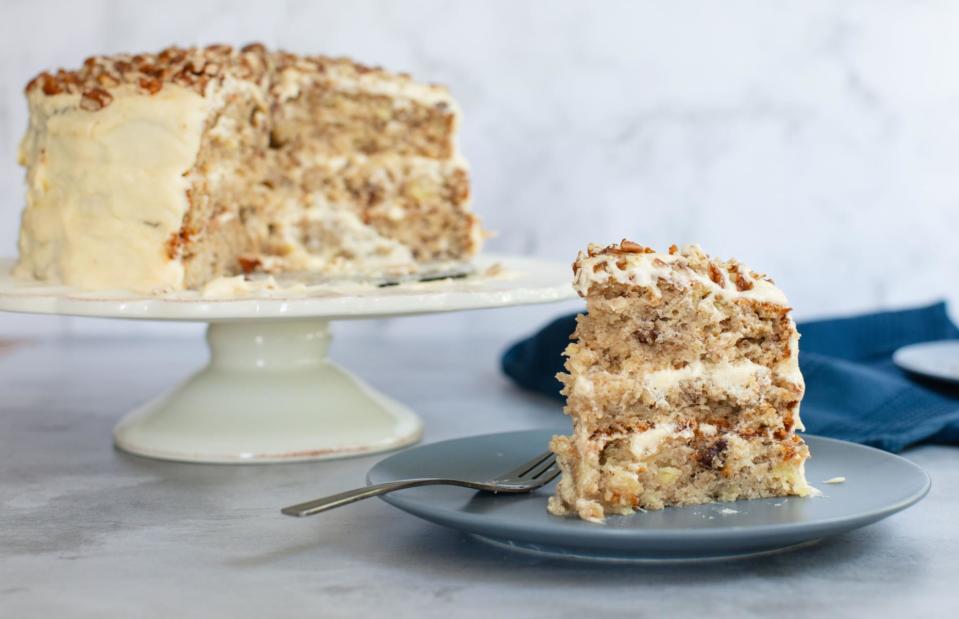
Michelle54/Shutterstock
Invented in Jamaica but enjoyed across the USA, the hummingbird cake gets its name from the island’s national bird: the scissors-tail hummingbird, known locally as the doctor bird. Perfect for summer, it combines two classic Jamaican ingredients – banana and pineapple – with spices and nuts, and it's packed with flavour and texture.
33. King cake, USA
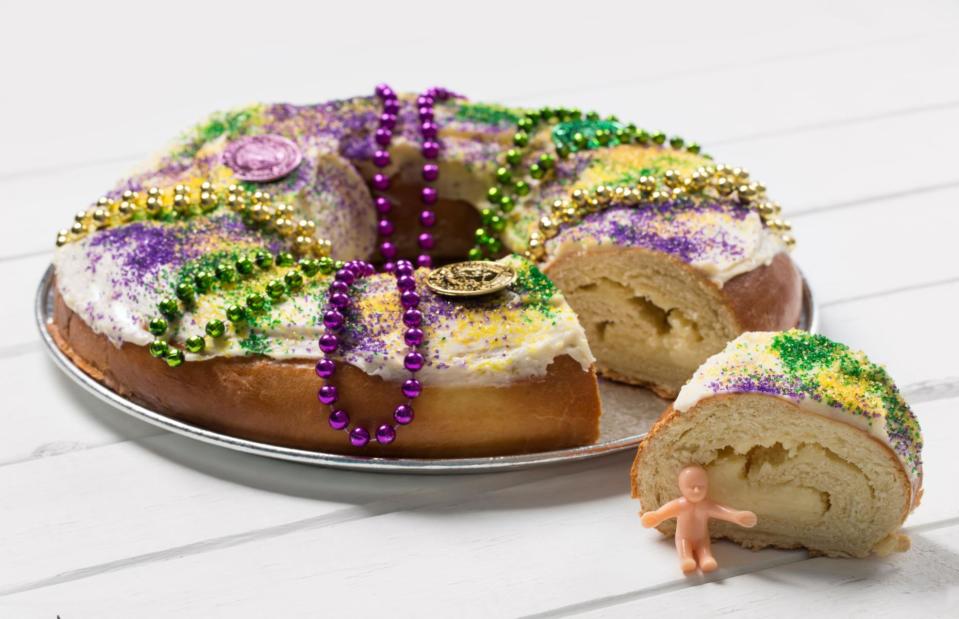
Jennifer White Maxwell/Shutterstock
When it’s carnival time in New Orleans, this tri-coloured confection pops up across the city. Somewhere between a coffee cake and a cinnamon roll, it’s filled with fruit and cream cheese and iced in the Mardi Gras colours of purple, green and gold. The name originates from the Biblical story of the Three Kings who carried gifts to Baby Jesus – which is why you’ll find a baby figurine in each bake. Traditionally, the person who finds it must either buy the next cake or throw a party.
32. Basbousa, Egypt

Veliavik/Shutterstock
Many Middle Eastern countries are known for simple yet rich desserts, and this Egyptian slice is a case in point. Made with semolina and coconut flakes, basbousa has a coarse texture similar to polenta cake. Yogurt adds moisture, while the finished cake is drizzled with a simple sugar syrup and delicately topped with a whole almond. You’ll also find variations in Palestine and Jordan, where the cake is more commonly called hareesa, but is made without coconut.
31. Dundee cake, Scotland, UK
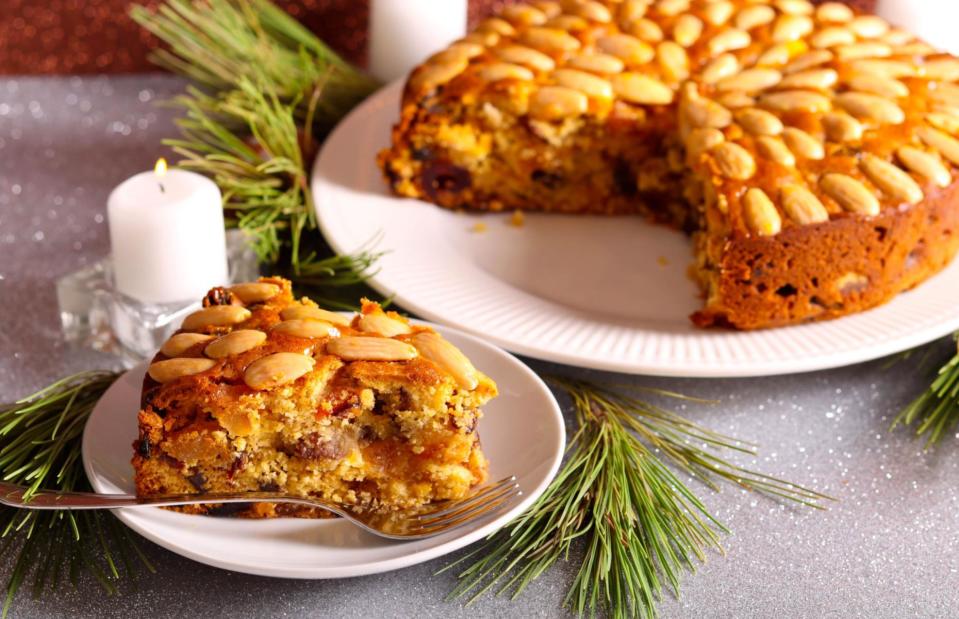
MShev/Shutterstock
Similar to Christmas cake, this round fruitcake is a Scottish classic. In fact, it’s such a cultural icon that its name is protected, meaning only cakes made to traditional specifications in the Dundee area can be called Dundee cake. Light and buttery, it gets its sweetness and texture from juicy sultanas, orange peel and almonds – and some recipes mix things up with marmalade and glacé cherries. Regardless, the cake is always topped with whole almonds.
30. Angel food cake, USA
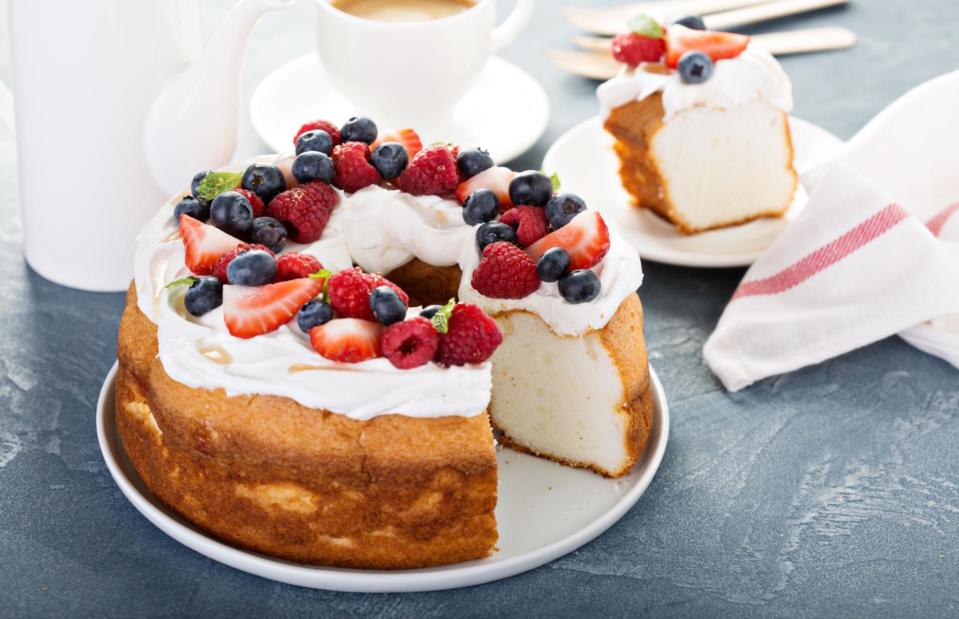
Elena Veselova/Shutterstock
This classic North American cake is the epitome of light and fluffy, with an airy, marshmallow-like texture that's obtained by whipping egg whites. Unlike other cakes, it doesn’t use butter or oil, which also explains its pristine white interior. The cake itself is kept simple, but the finished bake can be served with various toppings – usually whipped cream, fruit coulis, fresh berries or a glaze.
29. Rum cake, Caribbean
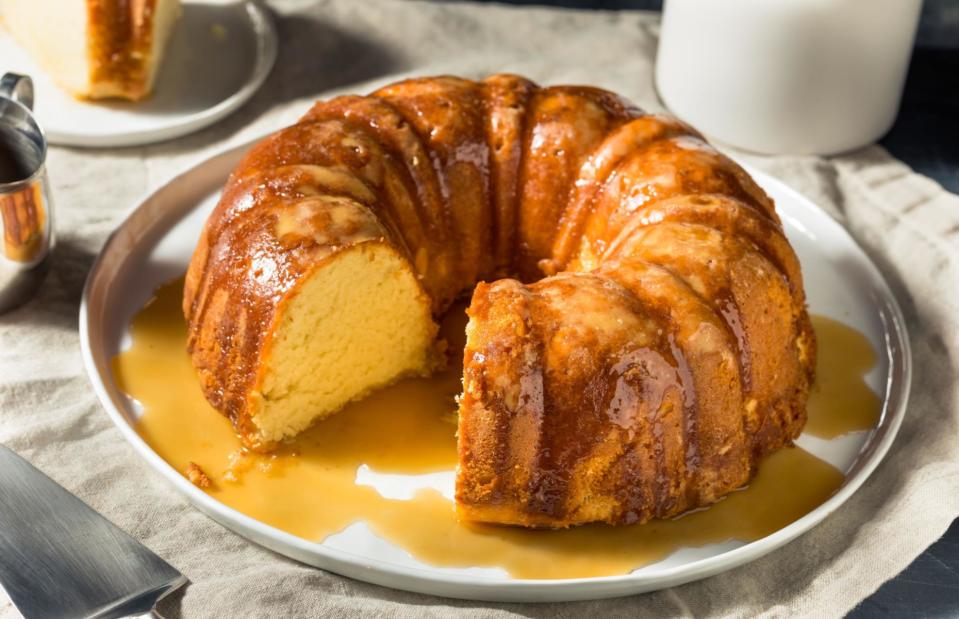
Brent Hofacker/Shutterstock
There are a couple of different variations on this Caribbean favourite. Black cake, so called because of its dark colour, is a rich fruitcake made with rum-soaked fruits. Originally called Empire Christmas pudding, it’s mostly found on the islands of the former British West Indies, and it features many of the commonly traded goods of the colonial period – including dried fruit, spices and molasses. Perhaps more common, the lighter version features a buttery cake base that's soaked in rum syrup.
28. Madeira cake, UK
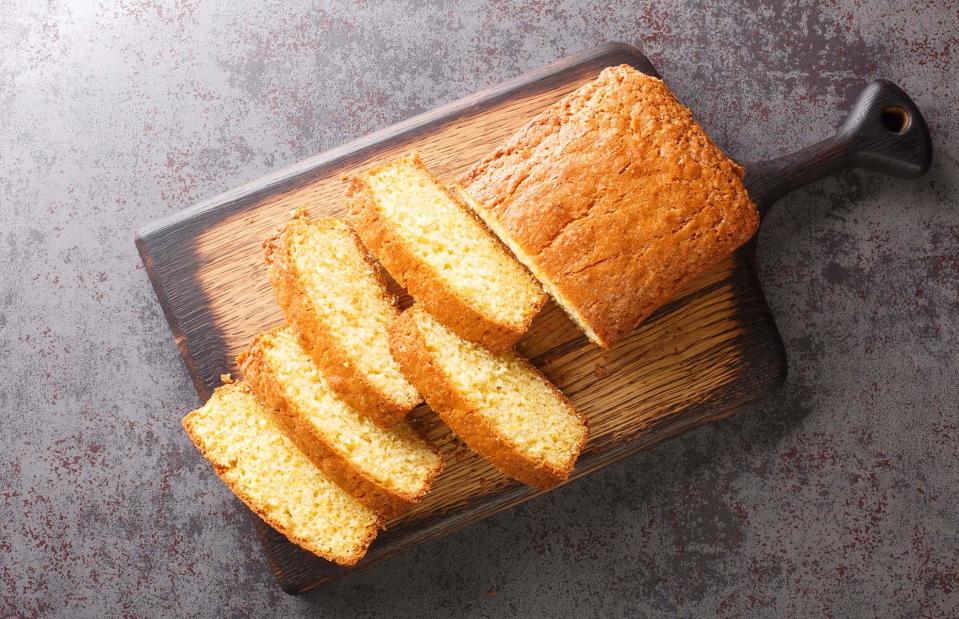
AS Foodstudio/Shutterstock
You could be forgiven for thinking that this sweet bake hails from Europe's Madeira islands, but it's actually another British invention; one of the earliest published Madeira cake recipes featured in Eliza Acton's 1845 cookbook Modern Cookery for Private Families. Beautifully simple, its sole ingredients are butter, sugar, eggs and flour (though some classic versions include lemon rind, too). So, why the name? It's all down to the fact that it was traditionally served alongside a glass of Madeira wine. A delicious-sounding combination, if you ask us!
27. Ice cream cake, various locations
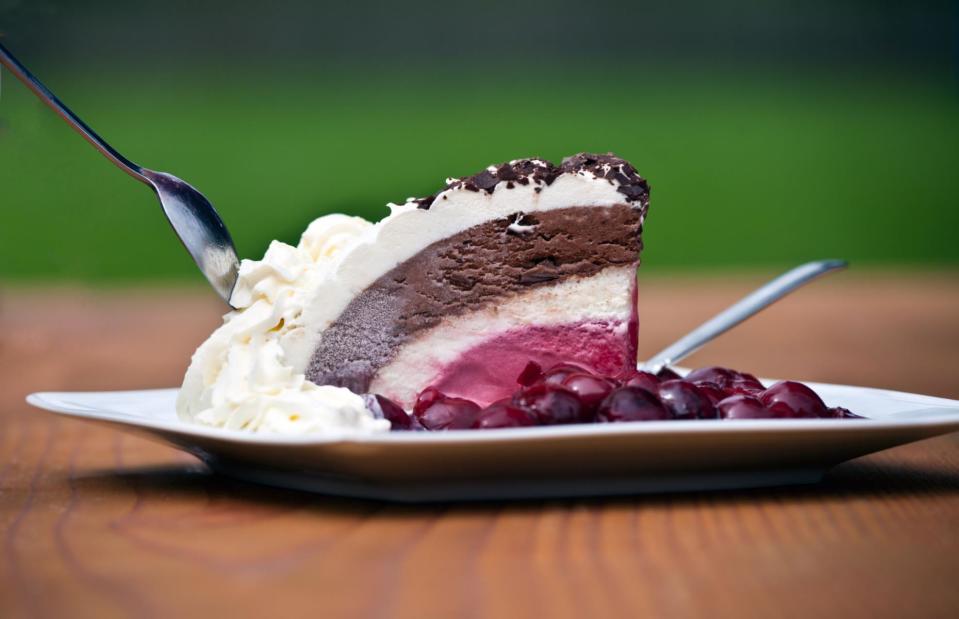
Margarita Borodina/Shutterstock
Cake and ice cream – what’s not to love? There's no one-size-fits-all recipe for ice cream cake. Instead, it can feature varying layers and flavours of ice cream and sponge cake, often topped with soft serve ice cream or cream. In some places it even takes the form of a Swiss roll, (see the UK’s Arctic roll for proof). Today it’s a popular feature of dessert tables at summer celebrations and birthday parties in Australia, North America and the UK.
26. Pineapple upside-down cake, USA

Lesya Dolyuk/Shutterstock
The origins of this fruity bake are said to date back hundreds of years, to when people used to cook in skillets over an open fire. Then, in the 1920s, fruit company Dole hosted a pineapple recipe contest, and around 2,500 people are said to have submitted pineapple upside-down cake. Dole published the recipe – and its popularity soared. The vanilla cake batter sits atop a layer of pineapples and maraschino cherries, which are mixed with butter and brown sugar. The baked cake is then flipped to reveal the caramelised fruit underneath.
25. Portokalopita, Greece
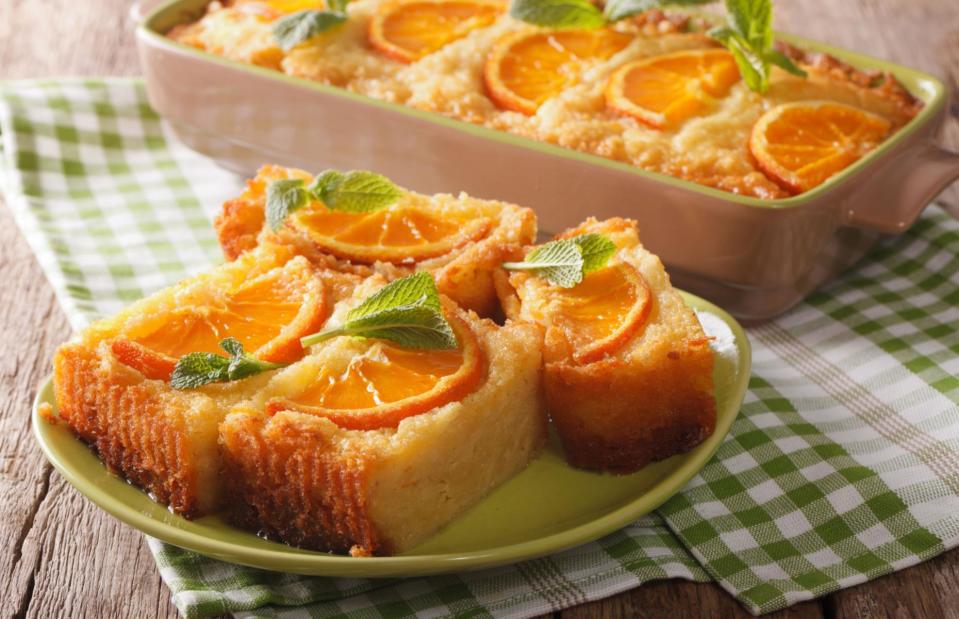
AS Foodstudio/Shutterstock
This traditional Greek cake isn’t quite a cake in the conventional sense. Rather than a sponge batter, portokalopita uses crumbled sheets of filo pastry in place of flour, and mixes them with oil, eggs and sugar to create a cake-like batter. After baking, a cinnamon-infused orange syrup is poured over the hot cake and left to cool, resulting in a sweet treat that's zesty and refreshing.
24. Bienenstich, Germany
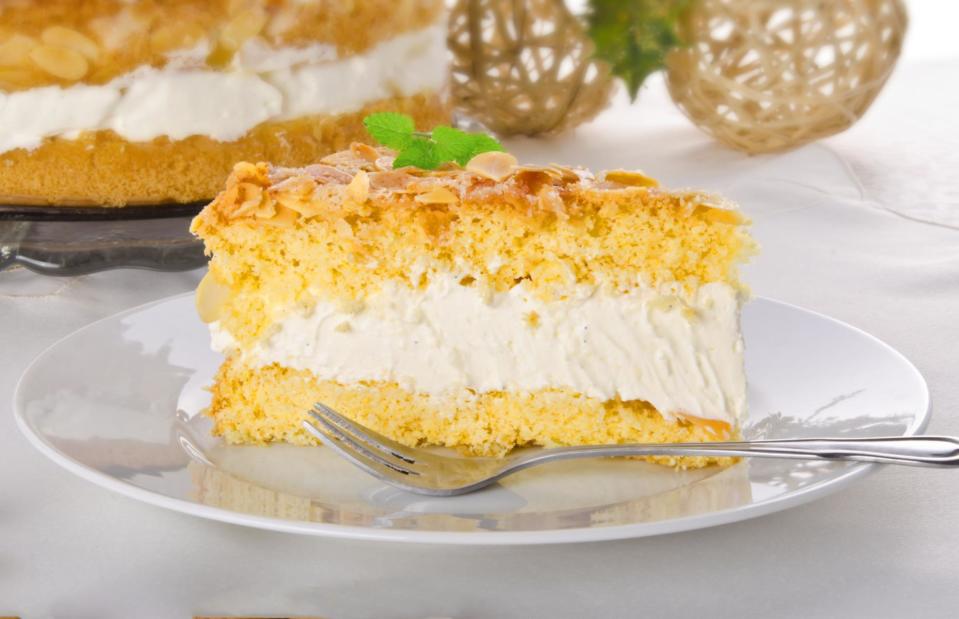
Dar1930/Shutterstock
The name of this German cake, which translates to bee sting, may not sound appealing – but trust us, it won’t bite! No one quite knows for sure who invented it, but one legend suggests it was first whipped up after a pair of baker’s apprentices threw a bee’s nest at some would-be attackers. Regardless of its origins, the combination of thin yeast dough, vanilla custard or cream filling and honey-glazed sliced almonds makes it a mouthwatering bake for any occasion.
23. Persian love cake, Iran
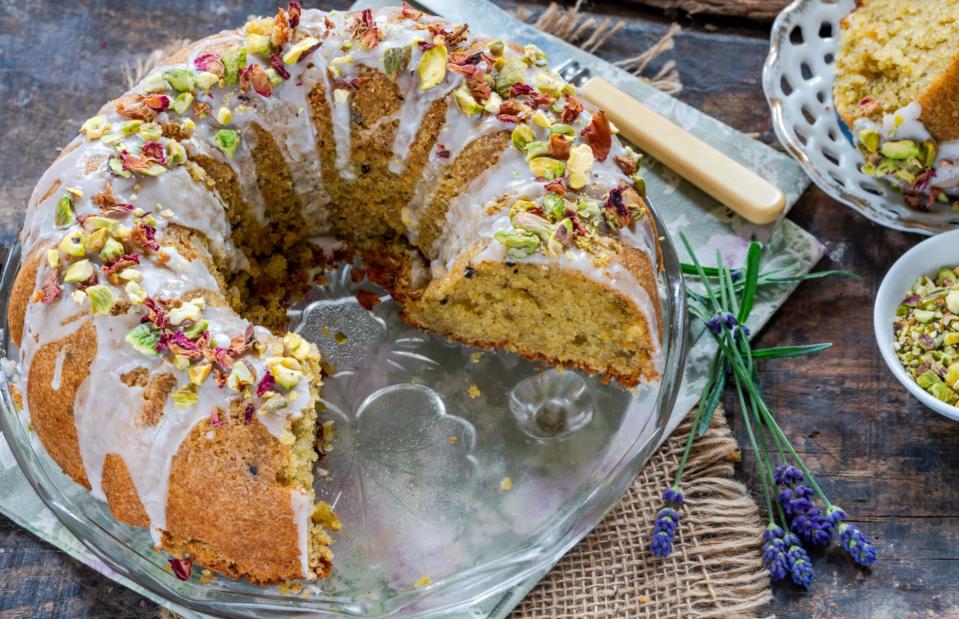
BBA Photography/Shutterstock
According to Iranian legend, this cake got its name after a young Persian woman made a cake infused with aromatic spices and rose water to make a prince fall in love with her. It combines some of the Middle East’s most celebrated ingredients – rose water, pistachios and lemon – and will immediately transport you to a Persian garden. Ground almonds give it a dense yet moist texture, while spices like cardamom, nutmeg and cinnamon add a delicate flavour. The baked cake is soaked in lemon syrup and topped with lemon icing, rose petals and crushed pistachios.
22. Chajá, Uruguay
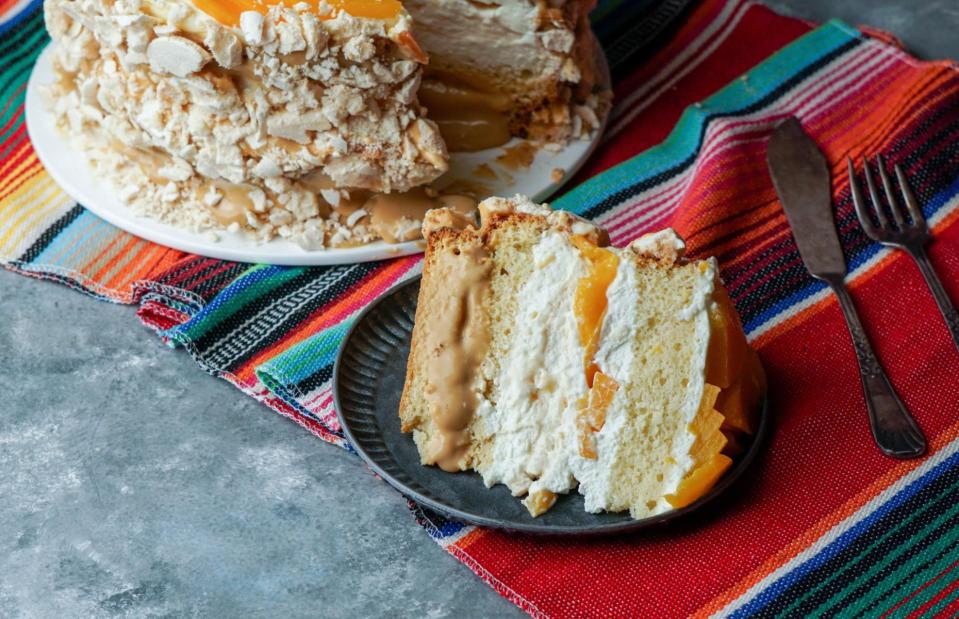
Julia-Bogdanova/Shutterstock
If you like your cakes with plenty of texture, look no further than this traditional Uruguayan bake, which is popular at celebrations and feasts. It’s named after the chajá bird, whose fluffy plumage is reflected in the finished product’s airy texture. Combining some of the best individual dessert ingredients into one, chajá is made with layers of light vanilla sponge, crunchy meringue, juicy peaches, whipped cream and (sometimes) dulce de leche, a type of condensed, caramelised milk.
21. Kvæfjordkake, Norway
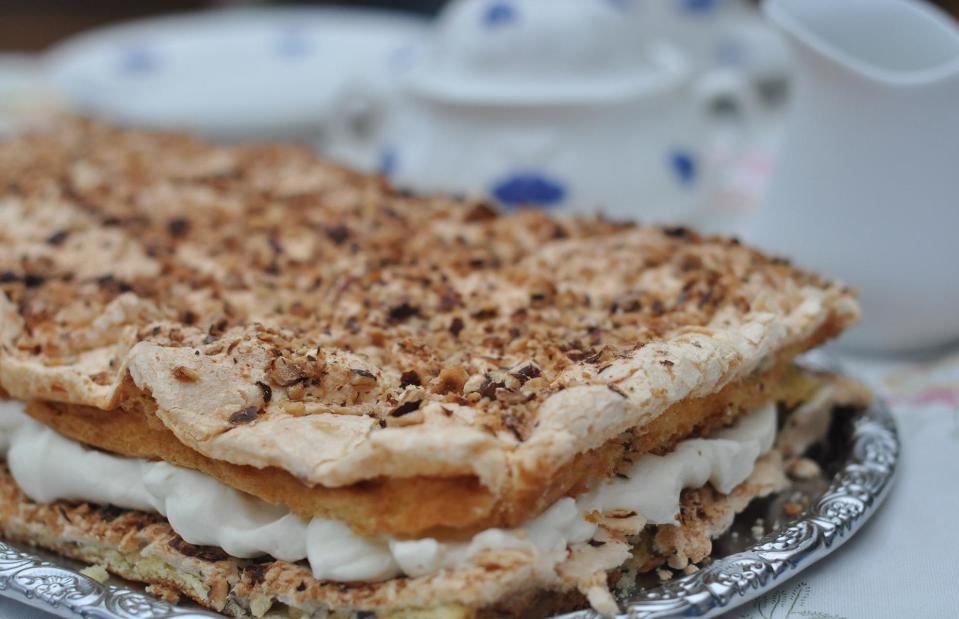
Zafer Yetim/Shutterstock
This cake is so beloved in its home country, Norway, that it's earned itself a nickname: 'verdens beste' (the world's best). Made with a luscious mixture of vanilla sponge, whipped cream, custard, meringue and almonds, we can see why its reputation precedes it – it has everything you could possibly want from a sweet treat, all stacked up in convenient layers. Its origins date back to the 1930s, when bakery owner Hulda Ottestad adapted a Danish cake recipe to include the ingredients she had to hand.
20. Tunnel of fudge cake, USA
![<p>Elaine Ashton/Flickr [CC BY-ND 2.0 DEED]</p>](https://s.yimg.com/ny/api/res/1.2/QH59LPbwHWrNIaBDzOeTgA--/YXBwaWQ9aGlnaGxhbmRlcjt3PTk2MDtoPTYxOQ--/https://media.zenfs.com/en/lovefood_uk_306/d17468a8ead1cfb4d2e4e018c5ee80f2)
Elaine Ashton/Flickr [CC BY-ND 2.0 DEED]
This decadently oozy little number burst onto the scene in the 1960s – instantly making bundt cakes the height of fashion. A nutty, chocolate-glazed, doughnut-shaped delight, the tunnel of fudge cake is so named for the gooey, fudgy tunnel that runs through its centre. This old-school sweet treat's story began in 1966, when it won second prize at America's famous Pillsbury Bake-Off Contest. However, its popularity soon eclipsed that of the competition's overall winner, Golden Gate snack bread, resulting in hundreds of thousands of home bakers contacting Pillsbury to find out where to buy a bundt pan.
19. Malva pudding, South Africa
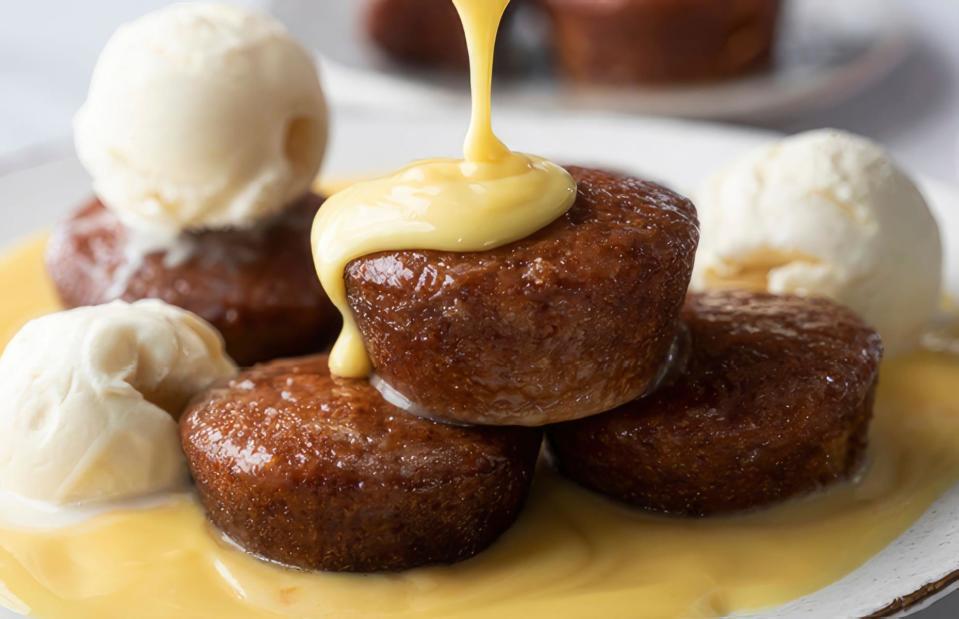
Thao Lan/Shutterstock
Unlike most cakes, Malva pudding is served warm – which is perhaps what makes it so wonderfully indulgent. Similar to British sticky toffee pudding, it features a soft, sponge-like batter that’s baked, then doused in a cream sauce. However, unlike the British version, Malva pudding includes apricot jam and a magical combination of baking soda and vinegar, resulting in a light and bubbly cake with a distinct caramelised taste.
18. Jamaican ginger cake, Jamaica and UK
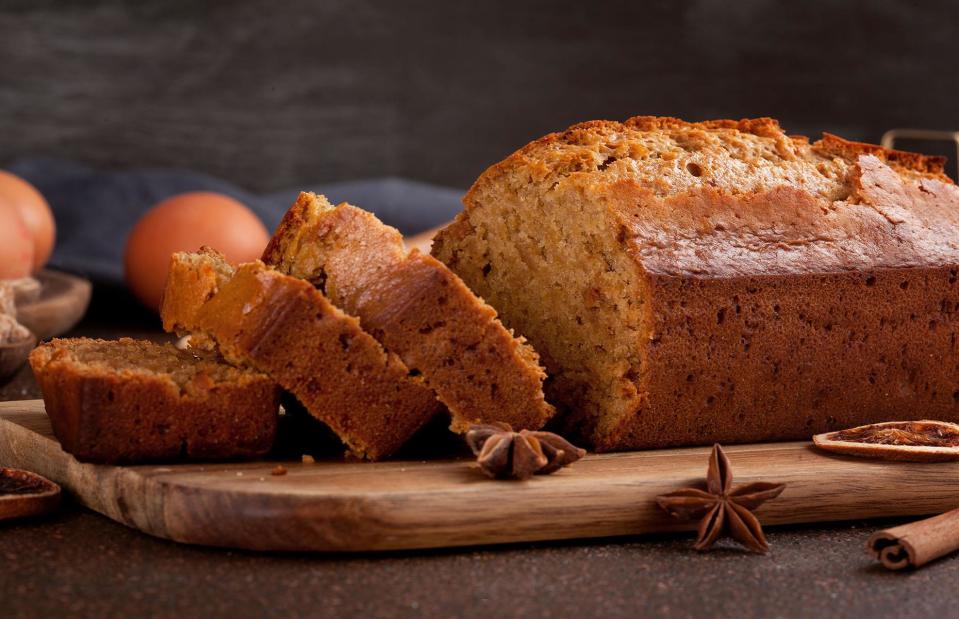
Netrun78/Shutterstock
Packed with fiery flavours, this sumptuous cake may technically have been invented in the UK, but it owes its sweet, spicy ingredients to Jamaica. It all goes back to the 18th century, when the Caribbean island nation began to export ginger and dark brown muscovado sugar to Britain. Ginger was originally used by Brits as a medicine to treat stomach pain, but they soon caught on to its potential as a bakery ingredient – and ginger cake was born.
17. Medovik, Russia
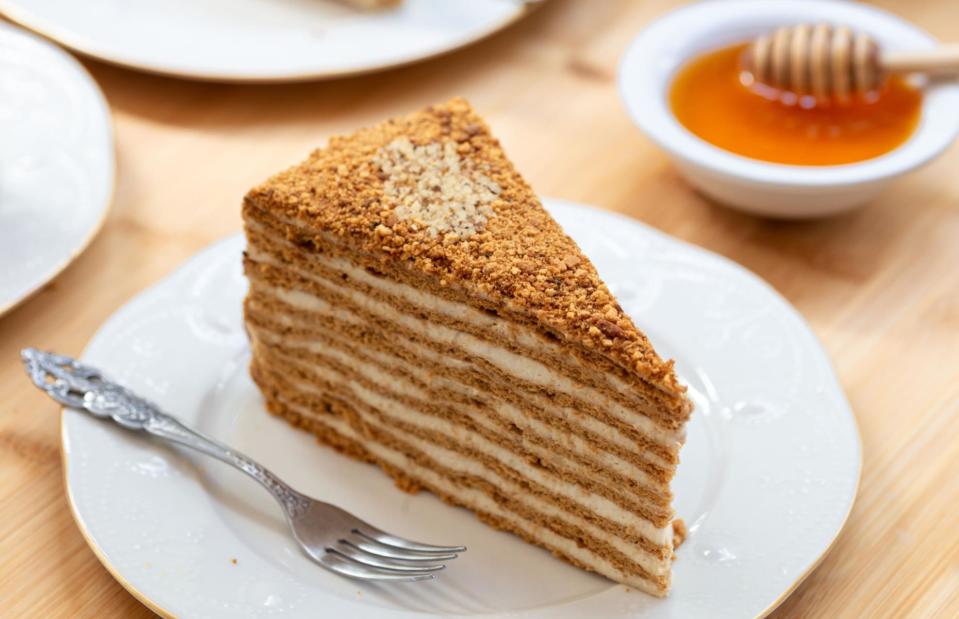
New Africa/Shutterstock
Also known as Russian honey cake, medovik dates back to the 19th century. Legend has it that a young baker in the Imperial kitchen baked a new cake with honey – but what he didn’t know was that the Empress, wife of Alexander I, wasn’t a fan of the sweet substance. Luckily for him, she didn’t know what the cake was made of, and fell in love with it. Today, the layered cake is still popular thanks to its caramel notes and sweetened sour cream filling.
16. Funfetti cake, USA
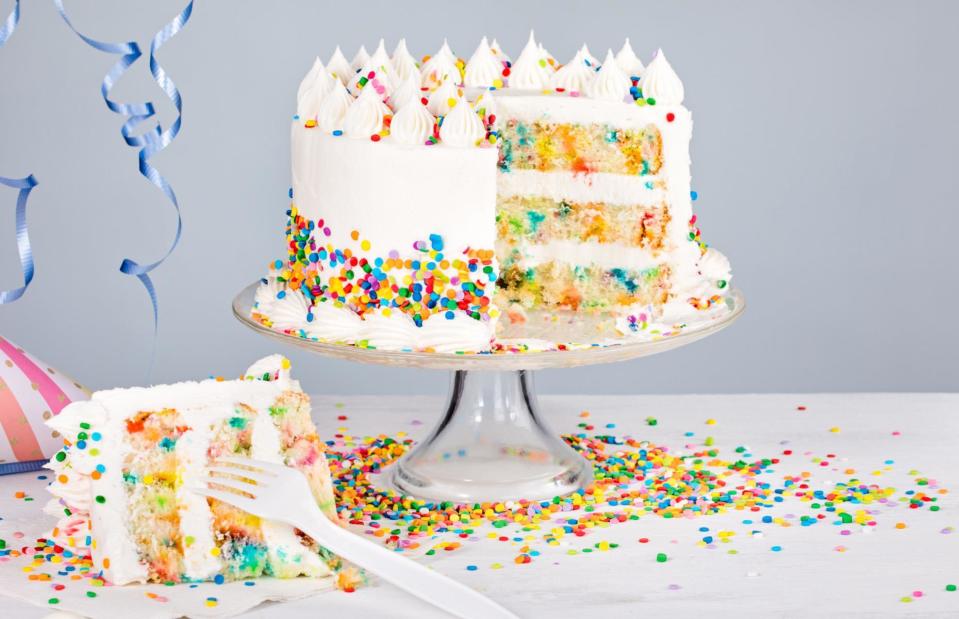
JFunk/Shutterstock
Compared with some of the other tasty entries on this list, Funfetti cake hasn't been around for all that long – but it sure has made a splash in its short lifetime. Introduced in 1989 by cake company Pillsbury, this multicoloured showstopper became an instant hit at children's birthday parties, and many 90s kids have fond memories of it to this day. To make it, rainbow sprinkles are stirred into a vanilla-flavoured batter, which is then baked and frosted with vanilla buttercream. The result? A cake that crams a whole lot of fun into every slice.
15. Lamingtons, Australia
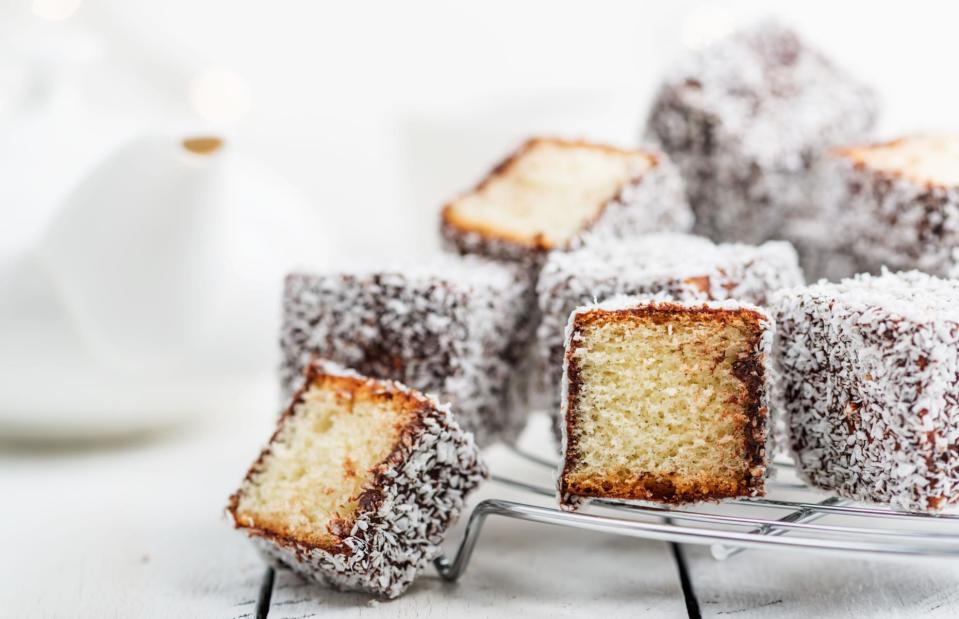
nelea33/Shutterstock
Arguably the most iconic Australian dessert, lamingtons are squares of butter cake or sponge cake, coated in chocolate sauce and desiccated coconut. It’s said that the lamington was invented after a maidservant accidentally dropped the favourite cake of Lord Lamington, the British Governor of Queensland from 1896 to 1901, into melted chocolate. Eager to avoid waste, Lord Lamington then suggested coating it in coconut. Lammos are now embedded in Aussie culture, though modern recipes can vary in flavour and colour.
14. Battenberg, England, UK
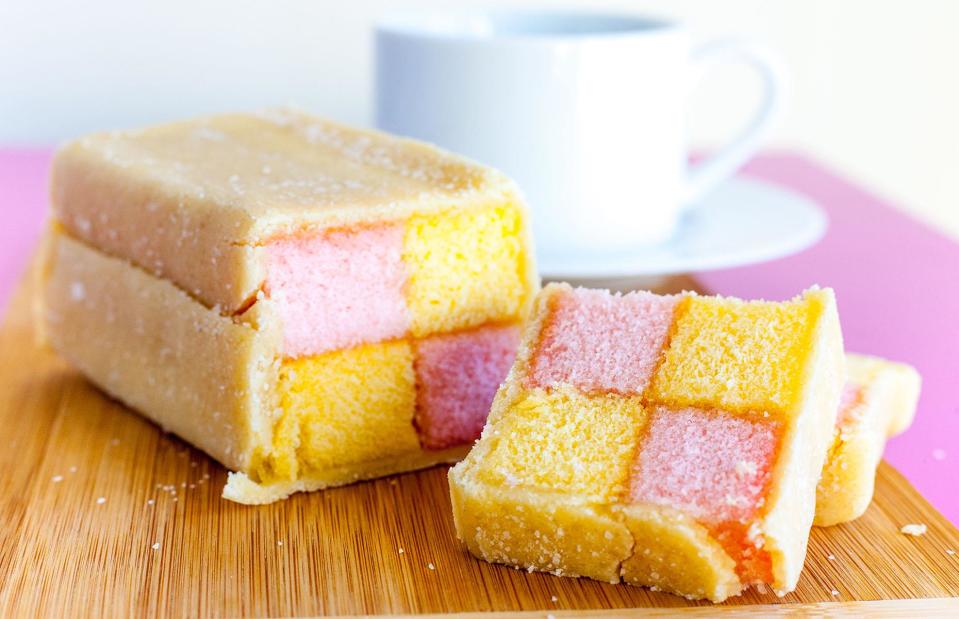
larry mcguirk/Shutterstock
Pretty as a picture or a stained-glass window, this rectangular English cake – consisting of alternating sections of pink and yellow Génoise sponge, held together with apricot jam and coated in marzipan – is said to have been created to celebrate the wedding of Prince Louis of Battenberg to Princess Victoria in 1884. Slicing this traditional treat into individual servings reveals the glorious chequered pattern that earned it many different names in the late 19th century, including domino cake, Neapolitan roll and church window cake.
13. Sachertorte, Austria
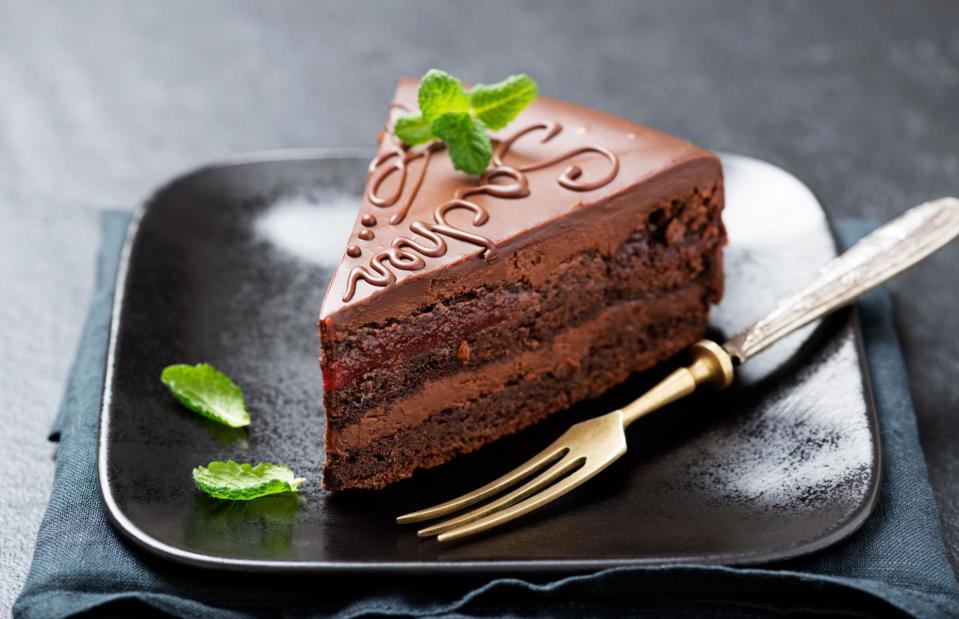
nelea33/Shutterstock
Though it's one of the most famous cakes in the world these days, the Sachertorte could very nearly have never been invented. The classic chocolate cake was created at a Viennese hotel by 16-year-old apprentice chef Franz Sacher in 1832. When the head chef was ill, Sacher was tasked with creating a novel cake for Prince Metternich and his guests. The result was a winning confection featuring apricot jam sandwiched between layers of rich chocolate sponge, all coated in a mirror glaze. A finish fit for royalty!
12. Opera cake, France
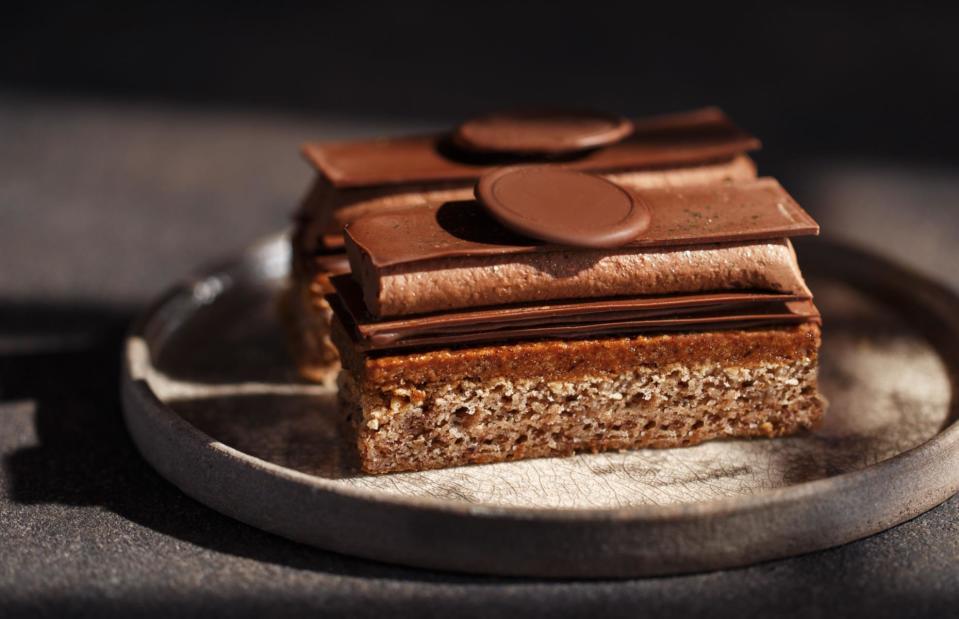
8H/Shutterstock
A must-have feature on any pâtisserie display, this French classic is the epitome of chocolate indulgence. The opera cake gets its name from its layers, which are said to resemble the levels of an opera house. Each of those layers – almond sponge soaked in coffee syrup, rich ganache, coffee buttercream and a silky chocolate glaze – is delicious in its own right. When combined, however, they make a mouthwatering cake that’s moist and rich.
11. Maple cake, Canada
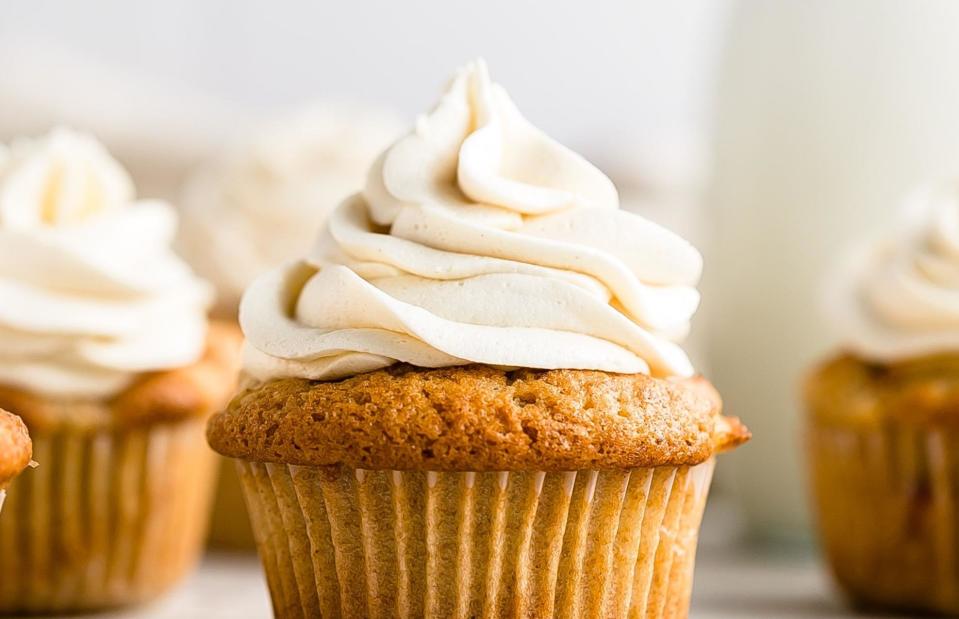
Truffles and Trends/Shutterstock
Is there anything more quintessentially Canadian than maple syrup? You’ve probably used this rich amber syrup to elevate pancakes or waffles – and that same sweetness lends a distinctive flavour to cakes, with a delicate nuttiness and hints of caramel and toffee. Maple cake can be made as a tray bake (also known as a snack cake), in layers or even as cupcakes. Either way, it uses a simple vanilla cake recipe laced with maple syrup, while the frosting is made with maple butter. Some recipes also add in spices like ground cinnamon, and chopped walnuts or pecans.
10. Lapis legit, Indonesia
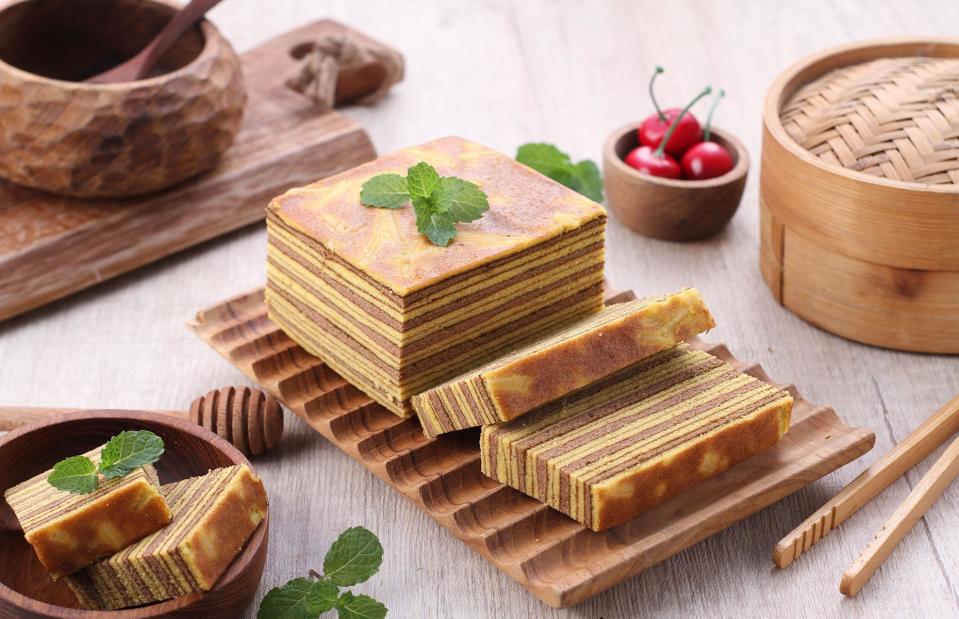
Ricky_herawan/Shutterstock
Meticulously neat, this impressive, many-layered cake was first created when Indonesia was under Dutch colonial rule, though no one knows for sure who came up with the recipe. It's also known by its Dutch name, spekkoek, which translates as 'pork belly cake' (a nod to its streaky, dark-and-light appearance). It's notoriously difficult to make, as each of its layers needs to be baked separately – and there can be up to 30 of them, made with egg yolks, sugar, flour, butter and a mix of spices. A real beauty of a cake, it's hugely popular during Indonesian holidays, and at weddings and birthday parties.
9. Swiss roll, Central Europe
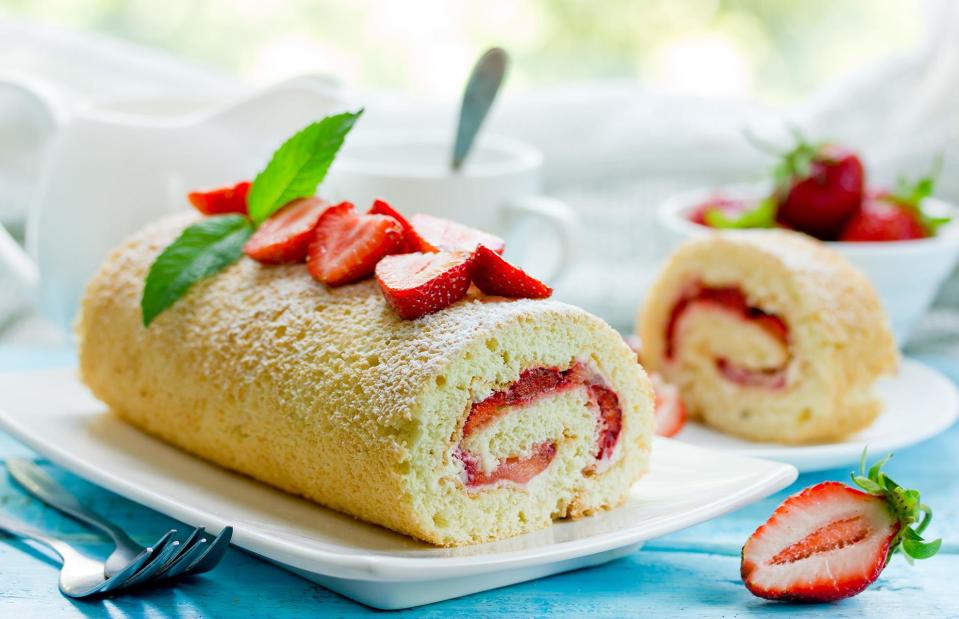
Anastasia_Panait/Shutterstock
Despite its name, this eye-catching cake is believed to have originated not in Switzerland, but elsewhere in Central Europe in the 19th century – perhaps in Slovenia or Austria. Depending on where you live, it may be known as a jelly roll, a roulade or a roll cake, but no matter what you call this spiral-shaped sponge, its deliciousness can't be denied. Its traditionally filled with a simple combination of whipped cream and jam, but these days you can find it in many forms, including chocolate versions and varieties filled with nuts or mascarpone.
8. Banana bread, USA
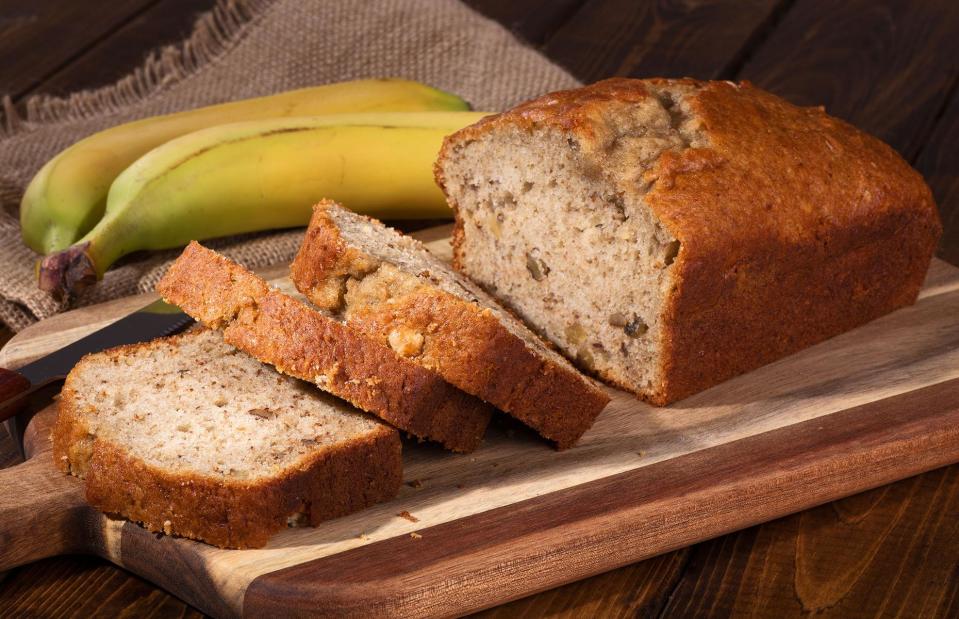
Charles Brutlag/Shutterstock
Banana bread is such a beloved staple of American cuisine that it has its own national appreciation day in the States (23 February, if you want a slice of the action). A delicacy that came into fashion during the Great Depression of the 1930s, the recipe is simple yet effective, making use of overripe bananas in the tastiest way possible. Though it's never really gone out of style, it saw a huge surge in popularity in home kitchens across the world during the COVID-19 pandemic, when it became one of the most-searched-for recipes on the internet.
7. Lemon drizzle cake, England, UK
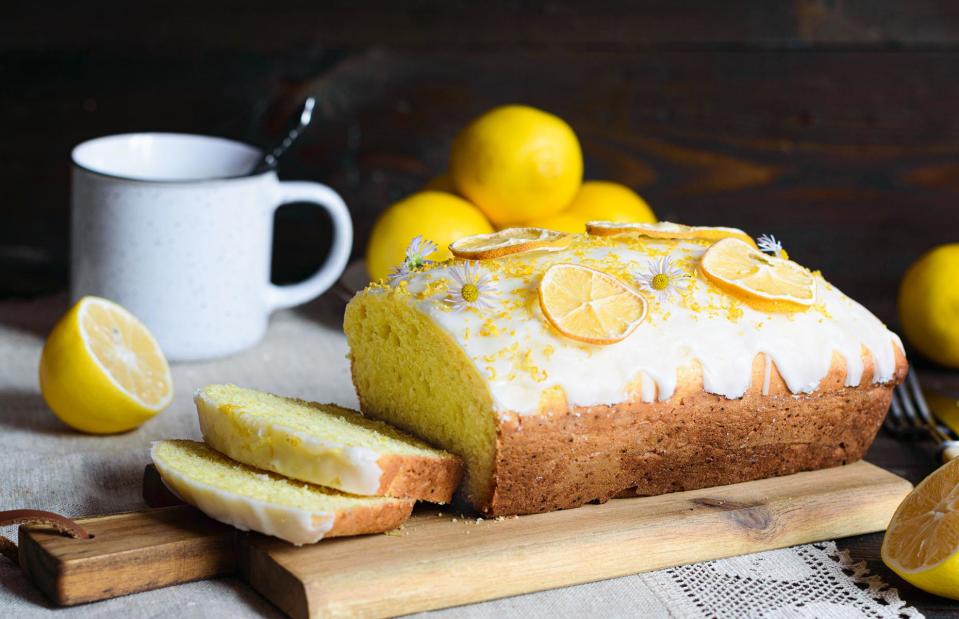
KseniyaBelova/Shutterstock
An English classic, this moist, indulgent cake is a lemon lover's dream come true. It evolved from another UK confection, pound cake, whose roots stretch back to the 17th century – and, though no one knows for sure who invented it, the version that's beloved in the British Isles (and beyond) today was popularised by cookery writer Evelyn Rose in the 1960s. In essence, it's a sponge cake that's flavoured with lemon zest and juice, then drizzled with a tangy lemon syrup. For the full afternoon tea experience, serve it alongside a steaming cup of Earl Grey; it'll bring out the acidic taste beautifully.
6. Carrot cake, various locations
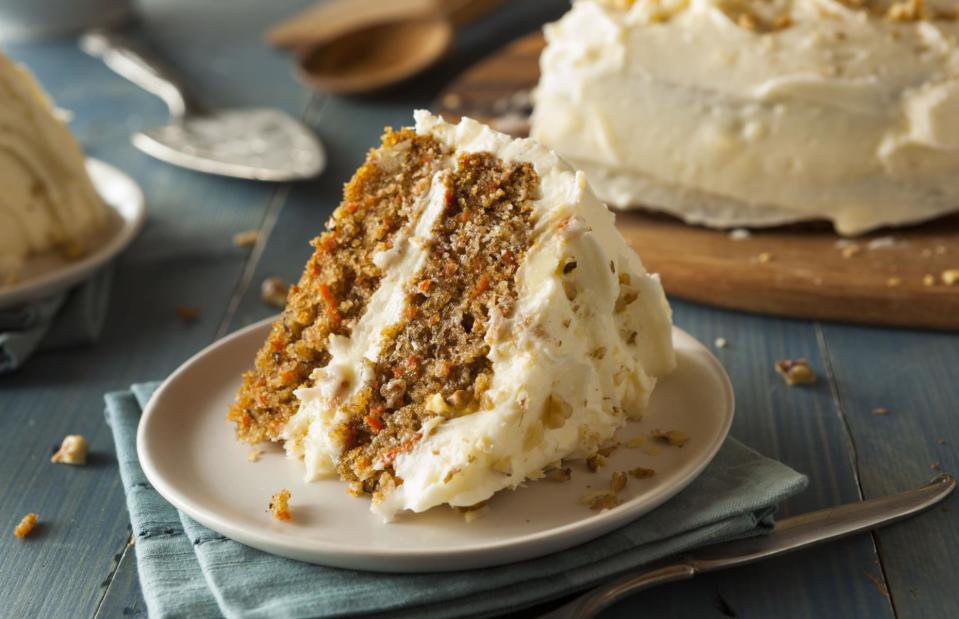
Brent Hofacker/Shutterstock
Depending on who you ask, carrot cake has lots of different origin stories. Some say it evolved from the European carrot puddings of the Middle Ages, while the modern cake has been traced back to early 19th-century recipes from a Swiss housekeeping school and a French cookbook. Its popularity surged during World War II – when, in the UK, carrots were used to sweeten cakes because of rationing. Regardless, it’s a wonderfully moist cake that's loved the world over for its natural sweetness, delicate spices and irresistible cream cheese frosting.
5. Schwarzwälder Kirschtorte, Germany
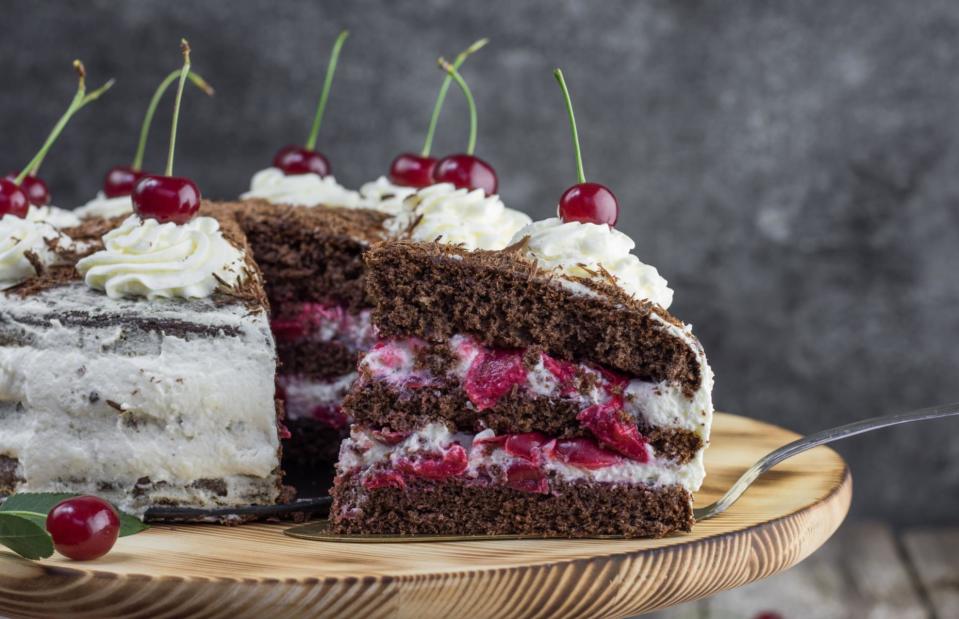
Jaromir Klein/Shutterstock
Schwarzwälder Kirschtorte (or Black Forest gâteau) is said to have been invented in the 1930s, and it's arguably Germany’s most famous dessert. Its name comes from a special cherry liqueur distilled in the Black Forest region – and it's this ingredient that gives the indulgent cake its unique flavour and colour. The traditional recipe sees a chocolate sponge soaked in sour cherry brandy Kirsch and layered with whipped cream. It’s usually topped with more cream, maraschino cherries and chocolate shavings; however, variations can include sour cherries, rum or cherry vodka.
4. Tres leches cake, Latin America
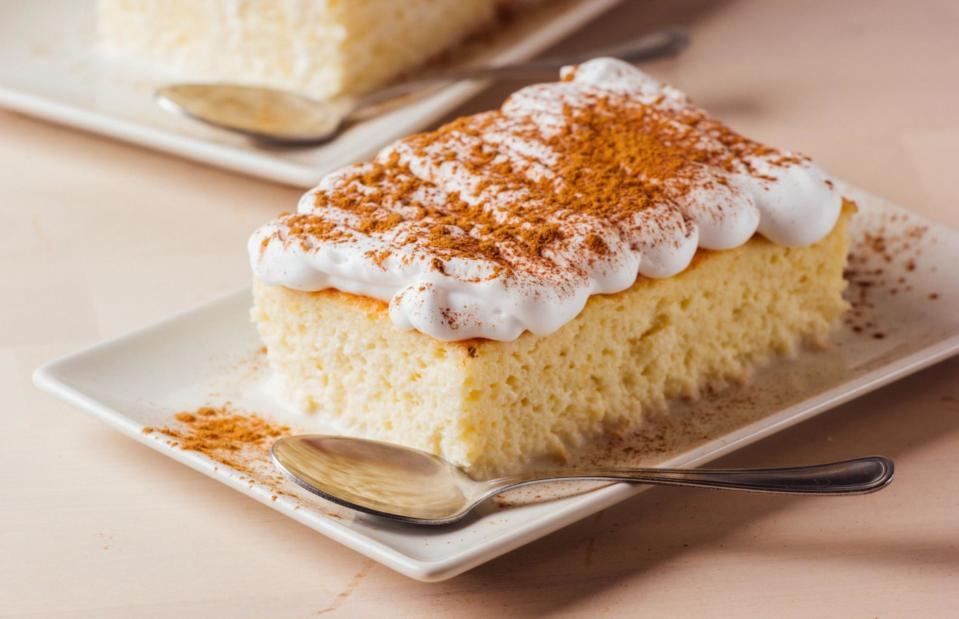
nehophoto/Shutterstock
Both Nicaragua and Mexico lay claim to this cake, though it’s now popular across Latin America and beyond. Spanish for three-milk cake, tres leches cake is similar to other soaked desserts like tiramisù and trifle. But while these desserts use alcohol, tres leches uses a sweetened mixture of evaporated, condensed and whole milk. This lends the sponge a distinct flavour and texture that’s moist but not soggy, and rich yet delicate. It’s topped with a thick layer of sweetened whipped cream and, sometimes, powdered cinnamon or fresh fruit.
3. Victoria sponge, England, UK
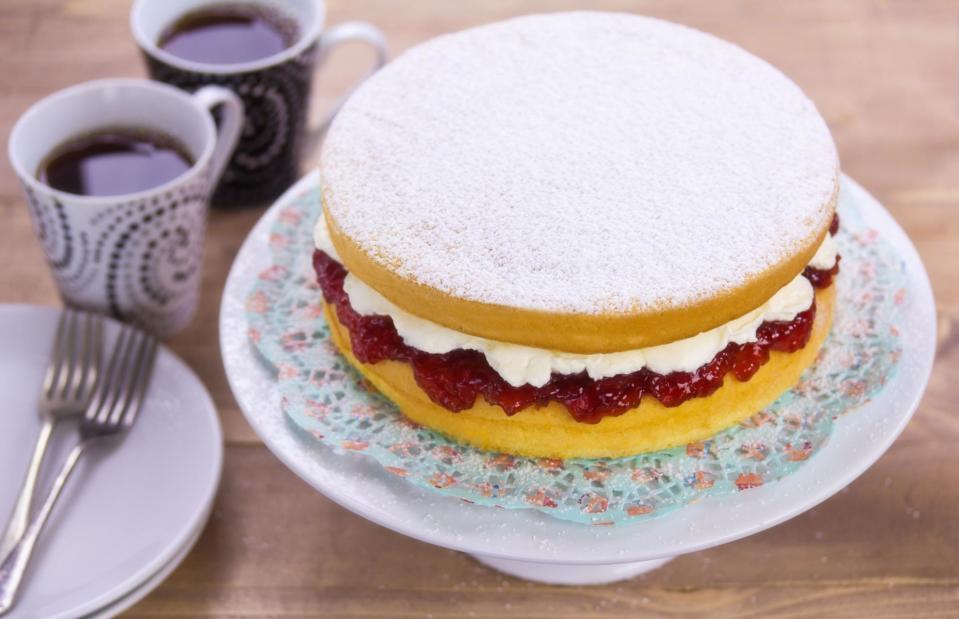
Bartosz Luczak/Shutterstock
If it's good enough for a queen, it’s good enough for us! This classic English cake was named after Queen Victoria; famed for her sweet tooth, she would make sure it was in pride of place at her formal afternoon tea gatherings. Her sandwich cake would have only featured jam – but today, cream is a welcome second filling, adding an extra layer of indulgence between the light and airy vanilla sponges.
2. Red velvet cake, USA
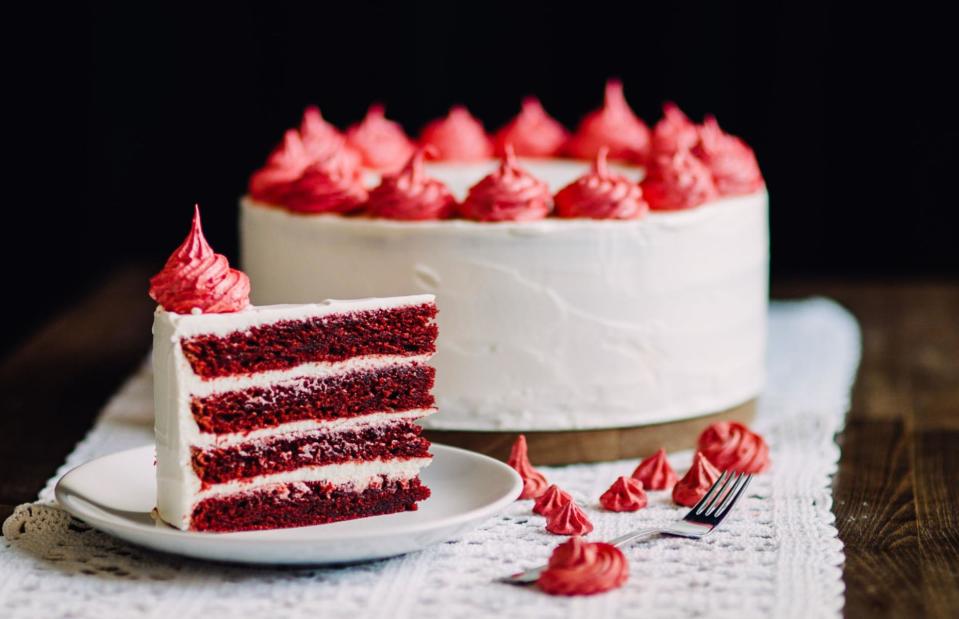
BRUI IRYNA/Shutterstock
This striking creation has its roots in the velvet cakes of Victorian England, which used cocoa powder for an extra touch of luxury. The red velvet cake as we know it, layered with buttercream, is often credited to New York's Waldorf Astoria hotel in the 1930s, though it had long been a favourite in the Southern United States. Traditionally, its rich red hue came from raw non-Dutch processed cocoa, which reacted with the batter’s acidic ingredients. Modern recipes typically use processed cocoa powder, so the vibrant colour is obtained from food colouring.
1. Chocolate cake, various locations
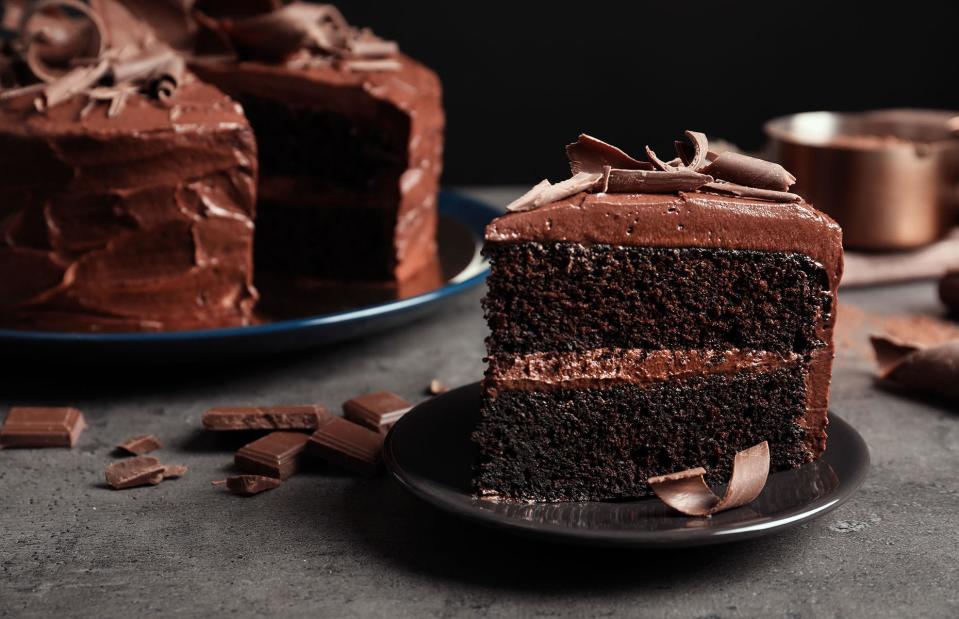
New Africa/Shutterstock
This crowd-pleasing bake comes in many guises, some of which feature on this list – but even at its most basic level, chocolate sponge covered in chocolate icing is the ultimate sweet treat. Its story dates back to 1828, when Dutch chemist Coenraad Johannes van Houten created Dutch process chocolate, a powdered chocolate that could be used in baking. However, it wasn't until the 20th century, when the mass production of baking powder and baking soda began, that the chocolate cake we know and love today arrived on the scene. These days, it continues to win hearts and bellies the world over.
Now discover our ranking of the world's best comfort food dishes
Last updated by Laura Ellis.


